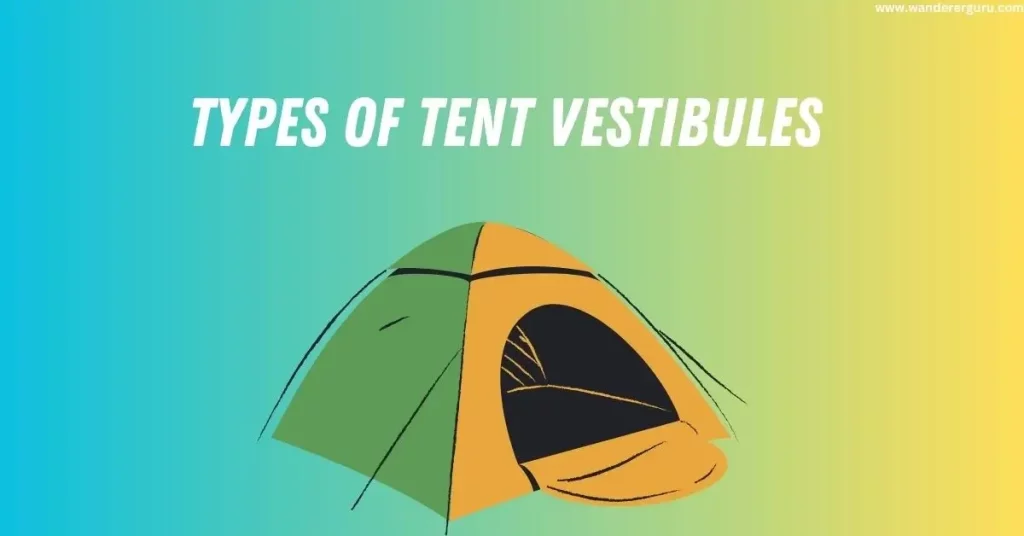A quality tent can need a unnoticed but serves a crucial purpose – the tent vestibule.when embarking on outdoor adventures. While most people are familiar with the main tent body, another essential feature often goes – the tent vestibule. In this comprehensive guide, we will explore the concept of a tent vestibule, its function, and the numerous benefits it offers to outdoor enthusiasts.
What is a Tent Vestibule?
A tent vestibule is an extension or covered area located at the entrance of a tent. It is designed to provide additional space and protection, acting as a buffer zone between the inside of the tent and the outdoors. Vestibules typically extend from the tent’s rainfly and are secured with stakes and guy lines to maintain stability.
Bonus:
BEST TENT STAKES ULTIMATE GUIDE
The function of a Tent Vestibule
The primary purpose of a tent vestibule is to enhance the overall functionality and comfort of the tent. Here’s a closer look at its essential functions:
Storage Space: One of the vestibule’s most significant advantages is its extra storage space. Campers can store their gear, backpacks, and muddy shoes in this area, keeping the main sleeping area clean and clutter-free.
Weather Protection: The vestibule is a protective barrier against the elements, such as rain, snow, and wind. It prevents rainwater from seeping into the tent when entering or exiting during inclement weather.
Ventilation Control: During hot and humid weather, campers can leave the vestibule partially open to maintain airflow while enjoying shade and sun protection.
Cooking Area: The vestibule can act as a makeshift kitchen when cooking inside the tent is not recommended due to safety concerns. Campers can prepare meals under shelter without compromising the tent’s interior.
Privacy: When camping with a group, the vestibule can provide an additional area for changing clothes or conducting personal tasks, granting campers privacy.
Types of Tent Vestibules

Tent vestibules come in various designs, each catering to different camping needs. The two main types are:
Integrated Vestibule: This type is directly attached to the tent and shares the same fabric as the rainfly. It offers seamless integration, ease of setup, and excellent protection from the elements.
Add-On Vestibule: An add-on vestibule is a separate extension that can be attached to the tent. It provides more flexibility as campers can choose to use it or leave it behind based on their specific camping requirements.
Benefits of Using a Tent Vestibule
Incorporating a tent vestibule into your camping setup brings many benefits that significantly enhance your outdoor experience. Some of the key advantages include:
Organization: By utilizing the extra storage space, campers can keep their gear organized and easily accessible, saving valuable time and effort in finding essentials.
Weatherproofing: The vestibule acts as a barrier, preventing rain and wind from entering the tent and keeping the interior dry and comfortable.
Extended Living Space: With a tent vestibule, you gain an additional area for various activities, such as cooking, lounging, or storing wet gear, enhancing the overall camping experience.
Durability: By protecting the main tent entrance from harsh weather conditions, the vestibule prolongs the tent’s lifespan, reducing wear and tear on the zippers and fabric.
Bonus:
DOME TENTS VS CABIN TENTS WHICH ONE IS BETTER?
Why is Tent Vestibule Important?
A tent vestibule is crucial because it provides essential camping and outdoor activities benefits. It serves as a buffer zone between the tent’s interior and the outside environment, keeping the interior clean and dry. Additionally, it offers extra storage space for gear, shoes, and other belongings, enhancing organization and convenience. The vestibule also acts as an additional protection against rain, wind, and insects. Overall, it plays a crucial role in ensuring comfort, cleanliness, and safety while camping, making it a vital feature in a tent.
Does tent vestibule size matter?
The size of a tent vestibule matters as it impacts camping comfort and functionality. An enormous lobby provides ample storage space for gear, enhances organization, and keeps the interior cleaner. It also allows for easy entry and exit without tracking dirt inside. Additionally, an enormous vestibule offers better protection from the elements, making it a more versatile area for relaxing or cooking. However, larger entrances may add weight and bulk to the tent, which could concern backpackers. Therefore, the ideal vestibule size depends on specific camping needs and preferences, balancing storage capacity and portability. For more ideas, visit my Pinterest.
How to assemble Tent Vestibule?
To build a tent vestibule, follow these steps:
- Lay out the tent and locate the vestibule attachment points.
- Connect the vestibule poles to the corresponding pole sleeves or clips on the tent.
- Stake down the corners of the vestibule to secure it in place.
- Adjust the tension of the vestibule to ensure a snug fit and proper rainfly alignment.
- Zip or attach the vestibule to the tent body.
- Use guylines and stakes to stabilize and secure the vestibule for better wind resistance.
- Finally, check for any loose connections or adjustments before use, ensuring a proper and functional setup.
Conclusion
In conclusion, a tent vestibule is a valuable addition to any camping setup. Its multifunctional design provides numerous benefits, from additional storage space and weather protection to improved organization and extended living areas. Whether you are a seasoned outdoor enthusiast or a novice camper, investing in a tent with a vestibule will undoubtedly elevate your camping experience to new heights of comfort and convenience. So, the next time you plan a camping trip, consider the vestibule your ultimate outdoor ally. Happy camping!
FAQs
What is a vestibule tent, and how does it work?
A vestibule is an extension or covered area located at the entrance of a tent. It serves as an additional space that acts as a buffer zone between the inside of the tent and the outdoors. The vestibule is typically attached to the tent’s rainfly and secured with stakes and guy lines. It provides several functions, such as weather protection, extra storage space, improved ventilation, and privacy during camping.
How does a tent vestibule enhance weather protection?
The vestibule offers an essential layer of weather protection by shielding the main tent entrance from rain, snow, wind, and other outdoor elements. When entering or exiting the tent, the vestibule prevents rainwater from dripping inside, keeping the interior dry and comfortable, even during inclement weather conditions.
Can a tent vestibule be used for storage, and how much gear can it accommodate?
Yes, it is a primarily used for storage. It provides campers extra space to organize their gear, backpacks, and camping equipment. The vestibule’s capacity depends on the tent’s size and design. Larger tents generally have more spacious halls, accommodating a significant amount of gear, making it easier to keep the main sleeping area tidy and clutter-free.
Is a vestibule for tent necessary for camping, or is it optional?
While a vestibule is not a mandatory component for camping, it offers numerous benefits that significantly enhance the camping experience. Campers who value weather protection, organization, privacy, and additional living space will find a vestibule invaluable. A threshold might be an optional feature for those who prefer minimalist camping or have limited camping gear.
Can a tent vestibule be used for cooking, and is it safe?
Yes, a vestibule can be utilized as a cooking area. It provides a sheltered space where campers can prepare meals, especially during inclement weather when cooking inside the tent is not recommended due to safety concerns. Cooking in the vestibule helps prevent the buildup of carbon monoxide and other potential hazards associated with cooking inside confined spaces, ensuring a safer camping experience. However, it’s essential to exercise caution, keep the vestibule well-ventilated, and use camping stoves responsibly to avoid accidents.
Bonus:

